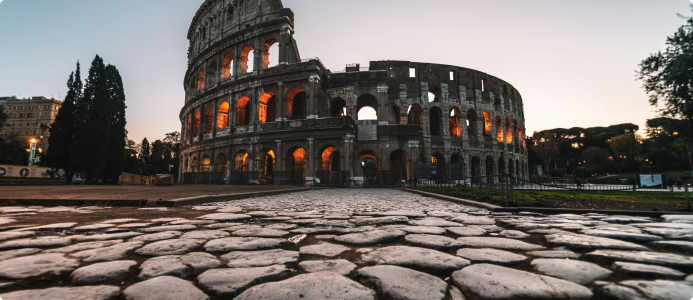Castello

Castello is the most authentic side of Venice. If you need a break from the tourist crowds, this magical district is where you can breathe in some fresh air. It’s the most intimate and genuine part of the city, where daily life and domestic tranquility shine.
Here, you’ll find the Napoleonic Gardens, home to the famous Venice Biennale every two years. You'll also find the massive Arsenal, where the world’s most powerful naval fleet was built starting in the 12th century.
Castello is the easternmost district of Venice. It’s the largest in terms of land area and the second largest in population. Unlike some other districts, Castello doesn’t border the Grand Canal. It stretches from the right of the Bridge of Sighs to the Riva dei Sette Martiri and down to the Fondamente Nove.
This district is all about the local vibe, with houses, fish markets, small squares, and churches. It’s quieter than other parts of Venice and is considered more picturesque.
History of Castello
Castello gets its name from the castle San Pietro di Castello, built to defend the area. Originally, it was made up of two islands, Giudecca and Olivolo, which were later connected. The district is rich in history, reflecting Venice’s working-class roots.
The eastern side of Venice, where Castello is located, has always been a working-class area. Locals live and work here, giving the district its unique charm.
The district is home to the Basilica of San Pietro di Castello, which was the seat of the Patriarch before the Basilica of St Mark took over. The Napoleonic Gardens and the Arsenal are historical landmarks that speak volumes about the district’s past. The Biennale Gardens, established during the Napoleonic era, host the prestigious Venice Biennale art exhibition. The Arsenal, a colossal shipyard, was pivotal in making Venice a maritime powerhouse.
Geography of Castello
Castello is the largest district in Venice by land area. It lies in the easternmost part of the city and does not border the Grand Canal. The district is shaped by its location, stretching from the right of the Bridge of Sighs to the Riva dei Sette Martiri and down to the Fondamente Nove. The area is predominantly flat, with narrow streets and canals winding through it.
The district’s layout is a mix of residential and historical areas. The eastern side, known for its working-class roots, is less touristy and more peaceful. The Napoleonic Gardens and the Arsenal are key landmarks in the district.
They provide green spaces and a touch of history to explore. Castello's geography adds to its charm, making it a delightful escape from the crowded areas.
Main Attractions in Castello

-
Venetian Arsenal
The Venetian Arsenal is a massive shipyard and armory that played a crucial role in Venice’s maritime dominance. Built-in the 12th century, it was the heart of Venice’s naval power. Visitors can explore its vast complex, which includes old shipbuilding docks and warehouses. It’s a must-see for history buffs and those interested in Venice’s naval heritage.
-
Libreria Acqua Alta
Libreria Acqua Alta is one of the most unique bookstores in the world. Its name means “Library of High Water,” and it’s famous for its quirky setup. Books are stored in bathtubs, boats, and even a gondola to protect them from Venice’s frequent flooding. It’s a charming place to browse and a photographer’s dream with its picturesque interior.
-
Cuore di Mattoni
Cuore di Mattoni, or Heart of Bricks, is a small, hidden gem in Castello. This quaint spot is a tribute to the traditional brick architecture of Venice. It’s a peaceful place to visit, offering a glimpse into the district’s architectural heritage. Visitors can enjoy the quiet ambiance and admire the intricate brickwork that characterizes many of Castello’s buildings.
-
Scuola di San Marco
The Scuola di San Marco is a stunning building that now houses the city’s main hospital. It started as a confraternity, a lay religious group that offered social services. The building’s facade is a masterpiece of Renaissance architecture, featuring intricate carvings and beautiful reliefs. It's worth a visit for its historical significance and beautiful architecture.
-
Scuola of San Giorgio degli Schiavoni
The Scuola of San Giorgio degli Schiavoni is another historical confraternity building. It’s famous for its series of paintings by Vittore Carpaccio, depicting scenes from the lives of saints. The interior is richly decorated, making it a must-visit for art lovers. The Scuola offers a glimpse into the religious and social history of Venice.
-
Church of San Zaccaria
The Church of San Zaccaria is a beautiful blend of Gothic and Renaissance architecture. It’s known for its stunning altarpiece by Giovanni Bellini and its peaceful, light-filled interior. The church also has a crypt that floods with water, adding to its unique charm. It’s a serene place to visit, offering a moment of tranquility away from the city’s busy streets.
-
Church of Sant'Elena
The Church of Sant'Elena is a beautiful spot in Castello dedicated to Saint Helena, the mother of Emperor Constantine. Built in the 15th century, it features lovely Gothic architecture and serene surroundings. Inside, you’ll find stunning frescoes and artwork that tell the story of Saint Helena. The church is set in a peaceful park, making it a perfect place to relax and enjoy some quiet time.
-
Church and Ospedale della Pietà
The Church and Ospedale della Pietà is famous for its connection to the composer Antonio Vivaldi, who taught music here. The church has a lovely Baroque facade and a richly decorated interior. It was built to provide shelter and care for abandoned children, and the music performed here was renowned throughout Europe. Visitors can explore its beautiful architecture and enjoy concerts that continue the musical tradition.